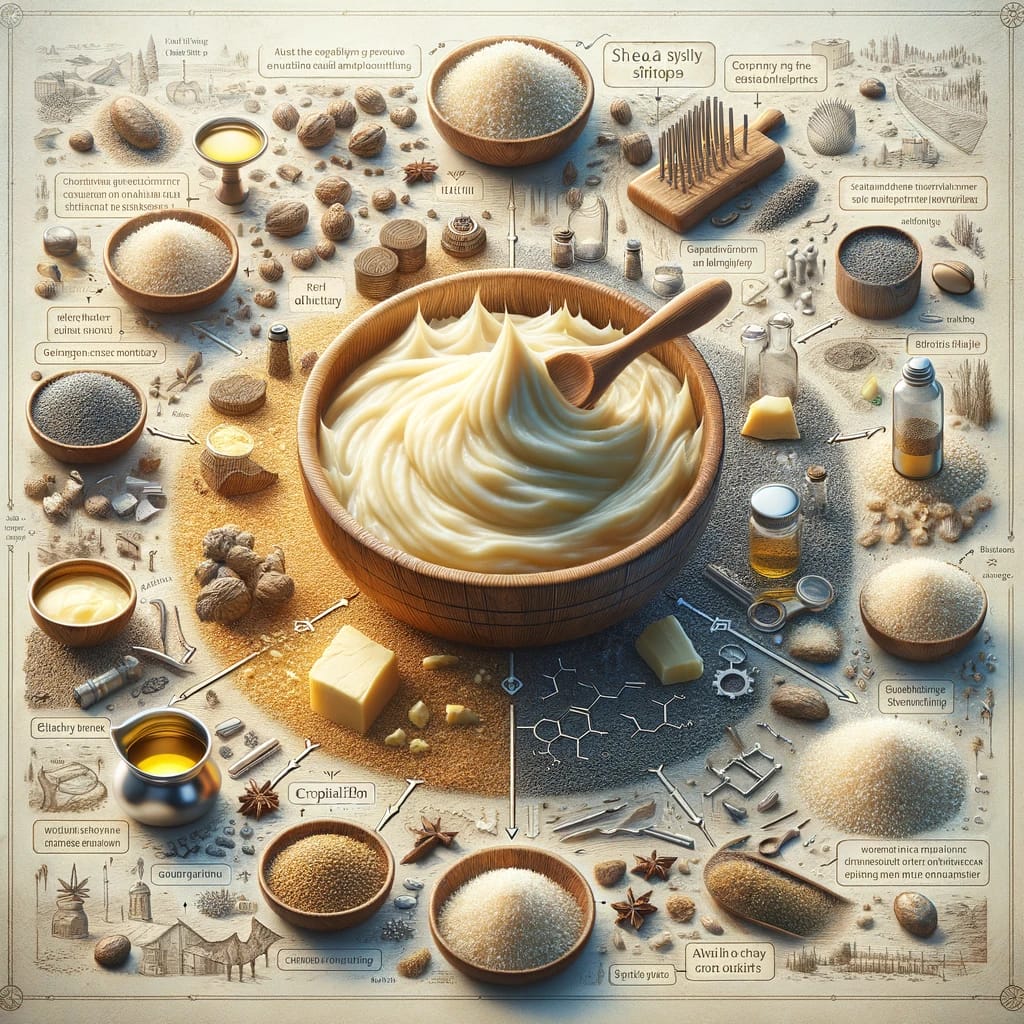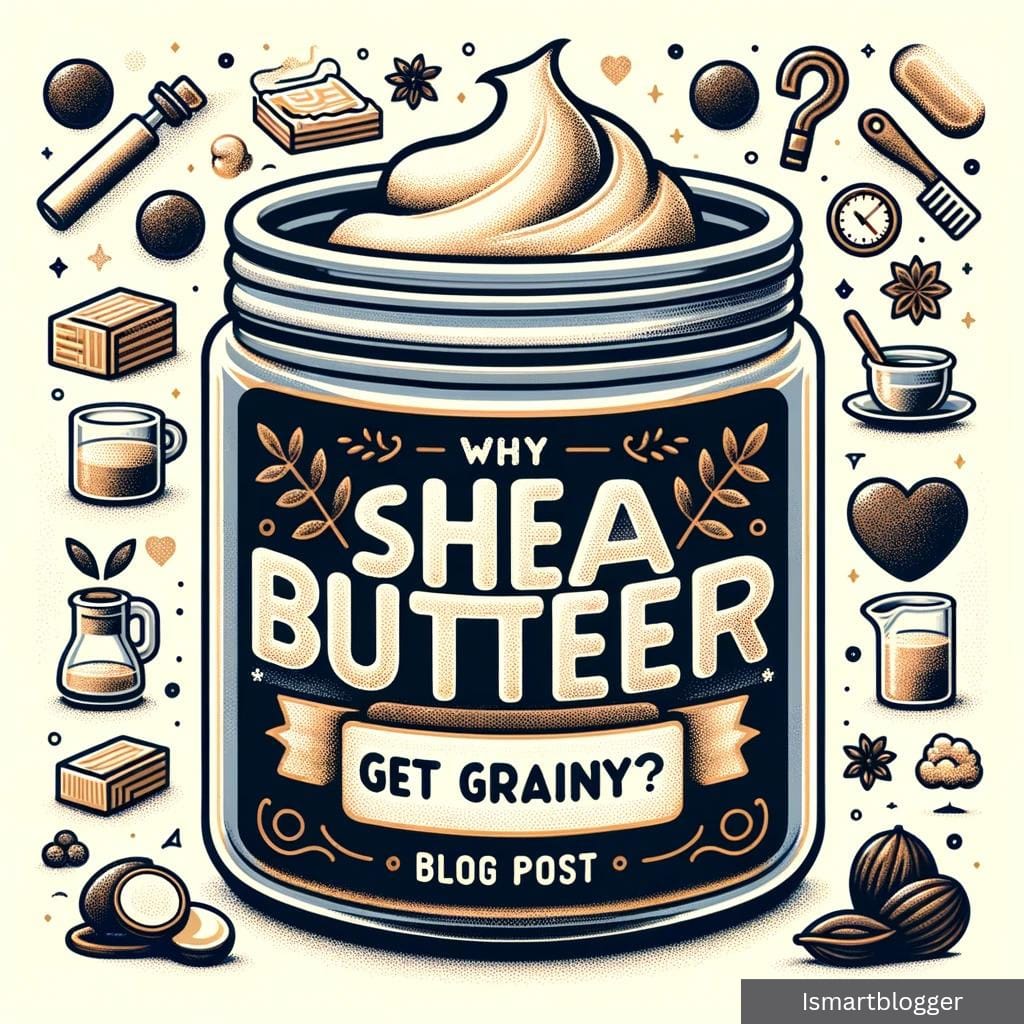Introduction
Shea Butter, with its rich and creamy texture, has gained immense popularity in the realm of skincare. Derived from the nuts of the Shea tree (Vitellaria paradoxa), which is native to West Africa, this natural ingredient has been cherished for centuries due to its exceptional moisturizing and nourishing properties. Its versatility makes it a staple in various skincare products such as lotions, creams, balms, and soaps.
The use of Shea Butter in skincare has surged in recent years as consumers increasingly seek out natural alternatives to synthetic ingredients. This natural butter is renowned for its ability to deeply penetrate the skin, promoting hydration and delivering essential nutrients.
It possesses powerful emollient properties that can alleviate dryness, soothe irritations, and improve elasticity. However, one common issue that can occur with Shea Butter is its tendency to become grainy over time.
Despite being an inconvenience for users who encounter this problem, it does not render the product unusable nor does it diminish its effectiveness. Understanding why Shea Butter undergoes this change can help users take appropriate measures to prevent or remedy graininess.

What is Shea Butter?
In its simplest form, Shea Butter is a natural fat extracted from the nuts of the African Shea tree, scientifically known as Vitellaria paradoxa. This miraculous substance has been used for centuries in African countries, particularly Ghana and Burkina Faso, due to its numerous skin and hair benefits. Shea Butter is renowned for its exceptional moisturizing and nourishing properties, making it a popular ingredient in various skincare products.
Definition and Origin of Shea Butter
Shea Butter is derived from the nuts of the Shea tree, which grows primarily in West Africa. The extraction process involves harvesting the nuts, cracking them open to reveal the kernels inside, and then grinding them into a paste.
This paste is typically roasted before being further processed to extract the precious oil content. The resulting product is a smooth butter-like consistency with a mild nutty aroma.
Extraction Process and Different Types
The extraction methods used can greatly influence the quality and characteristics of Shea Butter. Traditionally, communities in Africa relied on manual techniques such as hand-cracking and mortar-and-pestle grinding to produce unrefined or raw Shea Butter.
This type retains more of its natural compounds since it undergoes minimal processing. On the other hand, refined Shea Butter undergoes additional processing steps to remove impurities and obtain a more consistent texture.
This refinement may involve filtering or using solvents to purify the butter further. While refined Shea Butter may lack some of the nutrients found in unrefined versions due to processing, it still offers significant benefits for skincare.
Nutritional Composition and Beneficial Properties for Skin
Shea Butter contains an abundance of beneficial components that nourish and protect the skin. It is rich in essential fatty acids, including oleic acid, stearic acid, and linoleic acid. These fatty acids help to restore and maintain the skin’s natural lipid barrier, preventing moisture loss and promoting overall hydration.
Shea Butter also contains high levels of vitamins A and E, known for their antioxidant properties. These vitamins contribute to skin rejuvenation by neutralizing free radicals that can cause premature aging.
Additionally, Shea Butter possesses anti-inflammatory properties due to the presence of cinnamic acid derivatives such as lupeol cinnamate. Moreover, Shea Butter is emollient and easily absorbed by the skin, leaving it soft, supple, and protected against external aggressors.
Its moisturizing abilities make it particularly beneficial for dry or sensitive skin conditions such as eczema or psoriasis. Overall, Shea Butter’s nutritional composition makes it an exceptional ingredient for enhancing the health and appearance of the skin.
Why does Shea Butter become grainy?
Shea Butter, renowned for its incredible moisturizing properties and numerous skincare benefits, can occasionally present a rather perplexing problem – it becomes grainy. This phenomenon, often leaving users disappointed and confused, can be attributed to the crystallization process that occurs within the butter. Understanding the factors contributing to this graininess is crucial in preventing and addressing this issue effectively.
Explanation of the crystallization process in Shea Butter
To comprehend why Shea Butter becomes grainy, it is essential to dive into its molecular structure and composition. At room temperature, Shea Butter consists of various fatty acids, such as stearic acid and oleic acid.
These fatty acids are responsible for the creamy texture of Shea Butter when properly processed. However, over time or due to unfavorable conditions, these fatty acids can rearrange themselves into a crystalline form.
The presence of stearic acid and other fatty acids
Among the different types of fatty acids present in Shea Butter, stearic acid plays a significant role in triggering graininess. Stearic acid has a higher melting point compared to other fatty acids found in Shea Butter.
Thus, when exposed to temperature fluctuations or improper storage conditions, stearic acid tends to solidify more readily than other components. This results in the formation of uneven crystals within the butter, giving it a gritty texture.
Temperature fluctuations as a catalyst for crystallization
Temperature plays an influential role in hastening or exacerbating the crystallization process in Shea Butter. When exposed to fluctuating temperatures or subjected to rapid heating and cooling cycles, the stability of its molecular structure can be compromised. The repeated thermal stress causes stearic acid molecules within the butter to connect and form larger crystals that contribute to its graininess.
Role of impurities or contaminants in triggering graininess
Impurities or contaminants present in Shea Butter can also contribute to its grainy texture. When Shea Butter is not properly filtered or purified during the extraction process, small foreign particles, such as dirt or plant debris, can be trapped within its structure.
These impurities provide sites for crystal formation, further enhancing the likelihood of graininess. Similarly, if Shea Butter comes into contact with water or other substances that introduce contaminants or moisture, it can disrupt the butter’s composition and promote crystallization.
Understanding the underlying causes of Shea Butter’s graininess is essential for individuals who utilize this natural product in their skincare routines. By comprehending the crystallization process within Shea Butter and considering factors like fatty acid composition, temperature fluctuations, and impurities, users can take preventative measures to maintain the smooth and creamy consistency of this beloved skincare ingredient.
Factors contributing to graininess in Shea Butter
Storage conditions and improper handling
One of the primary factors that contribute to the graininess of Shea Butter is the improper storage conditions and handling. Shea Butter is highly sensitive to temperature fluctuations, moisture, and light exposure.
When stored in unfavorable conditions, such as high temperatures or direct sunlight, Shea Butter undergoes changes in its physical structure, leading to graininess. Heat can cause the fatty acids present in Shea Butter to solidify unevenly, resulting in a gritty texture.
Exposure to high temperatures or direct sunlight
Exposing Shea Butter to high temperatures or direct sunlight accelerates the crystallization process within the butter. This occurs due to the presence of stearic acid and other fatty acids that naturally exist in Shea Butter.
These fatty acids have different melting points, with stearic acid being one of the main culprits behind graininess. When subjected to heat or direct sunlight for prolonged periods, these fatty acids solidify at varying rates, leading to an inconsistent texture.
Repeated melting and solidifying cycles causing instability
Shea Butter can become grainy if it goes through repeated melting and solidifying cycles. While it is normal for Shea Butter to melt when exposed to heat and solidify when cooled again, frequent fluctuations between these states can result in instability within its molecular structure.
Each time it goes through this cycle, there is a higher chance for crystals forming within the butter. Over time, these crystals accumulate and give rise to a gritty texture.
Contamination from water or other substances
Another factor contributing to graininess in Shea Butter is contamination from water or other substances. Moisture acts as a catalyst for crystallization since water molecules can trigger crystal formation within the butter’s structure.
Similarly, if any impurities are present in the Shea Butter, such as dirt or other oils, they can disrupt the butter’s stability and cause graininess. It is crucial to handle Shea Butter with clean utensils and store it away from any potential contaminants to maintain its smooth consistency.
Preventing graininess in Shea Butter
A: Proper storage techniques Proper storage techniques play a crucial role in maintaining the smooth texture of Shea Butter and preventing it from becoming grainy. Firstly, it is essential to store Shea Butter in cool, dry places away from direct sunlight.
Excessive heat can accelerate the crystallization process, leading to graininess. Therefore, it is advisable to keep Shea Butter away from radiators or windowsills where temperatures can fluctuate.
An effective way to minimize exposure to air is by using airtight containers for storing Shea Butter. Oxygen exposure can cause the oils in the butter to oxidize, leading to changes in texture and potential graininess.
By sealing the container tightly after use, you create a protective barrier that helps preserve its smooth consistency. Furthermore, avoiding contact with water or moisture is imperative in preventing graininess.
Moisture acts as a catalyst for crystallization and can introduce impurities into the butter. Always ensure your hands are dry before handling Shea Butter and be cautious not to introduce any water into the container while scooping or applying it.
B: Correct handling methods
1: Gentle heating using double boiler method Gentle heating using the double boiler method is essential while melting Shea Butter as excessive heat can destabilize its structure, resulting in graininess. The double boiler method involves placing a heatproof bowl containing Shea Butter on top of a pot filled with simmering water.
This indirect heat allows gradual melting without exposing the butter directly to high temperatures. During the melting process, it is vital to stir occasionally to ensure even distribution of heat and prevent hot spots that may lead to localized crystallization.
Gently stir with a spoon or spatula until the butter has completely melted and acquired a smooth consistency. Upon melting, it is crucial to allow Shea Butter to cool gradually without subjecting it to sudden temperature changes.
Rapid cooling can promote the formation of crystals, resulting in graininess. Find a stable, room-temperature spot where Shea Butter can cool undisturbed for several hours.
C: Filtering out impurities before use
1: Straining melted butter through cheesecloth or fine sieve To ensure a smooth texture and remove any potential impurities that could contribute to graininess, it is recommended to strain the melted Shea Butter through a cheesecloth or fine sieve.
This process helps eliminate any solid particles or contaminants that may have been present in the butter. The strained liquid butter can then be collected and transferred to its storage container.
Additionally, visually inspect the strained Shea Butter for any remaining solid particles that escaped the straining process. By removing these particles using a clean spoon or spatula before use, you further minimize the risk of encountering graininess while applying Shea Butter onto your skin.
Remedies
The Importance of Reheating and Re-Melting
One of the key remedies to address graininess in Shea Butter is the process of reheating and re-melting. When Shea Butter becomes grainy, it indicates that the stearic acid crystals have formed unevenly. By gently reheating the butter using a double boiler method, these crystals can be melted again, allowing for a more uniform consistency.
It is crucial to avoid direct heat or microwaving as it can cause overheating and further damage the butter’s texture. Stirring occasionally during the melting process ensures even distribution of heat, helping to break down any remaining crystalline structures.
The Filtering Technique
Another effective remedy involves filtering out impurities that may contribute to graininess in Shea Butter. After melting the butter, strain it through a cheesecloth or fine sieve to remove any solid particles or contaminants present.
This step not only helps eliminate potential triggers for crystallization but also guarantees a smoother and more aesthetically pleasing end product. Take care to be thorough when straining, ensuring that no residue remains that could potentially cause graininess upon cooling.
Proper Storage Techniques
Preventing graininess begins with proper storage techniques for Shea Butter. It is essential to store it in cool, dry places away from direct sunlight as excessive heat can accelerate crystal formation.
Using airtight containers minimizes exposure to air and moisture, reducing the chances of crystal development. Additionally, avoiding contact with water or any other liquids is crucial because water acts as a catalyst for crystallization processes.
Conclusion
Although graininess in Shea Butter can be an unfortunate occurrence due to its natural composition and sensitivity to environmental factors, there are remedies available to restore its smoothness and quality. By carefully reheating and re-melting the butter, filtering out impurities, and implementing proper storage techniques, users can minimize the chances of graininess and enjoy the full benefits of Shea Butter.
Don’t let occasional graininess deter you from experiencing the remarkable properties this natural emollient offers for skin care. With a little knowledge and proper handling, Shea Butter can continue to be a reliable ally in your skincare routine – providing nourishment, hydration, and a touch of luxury.

